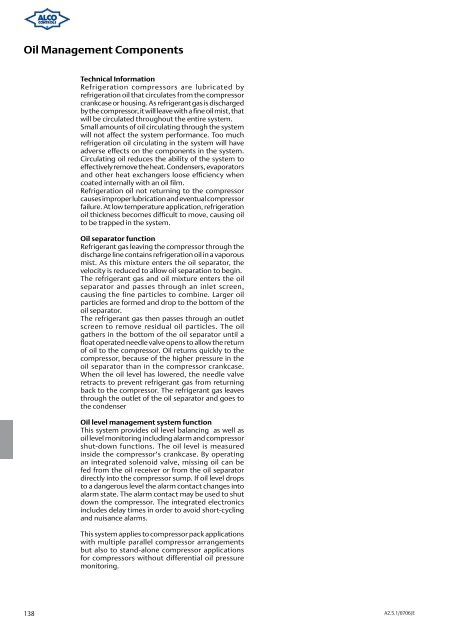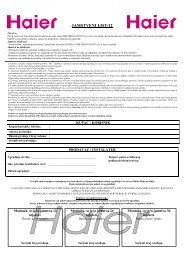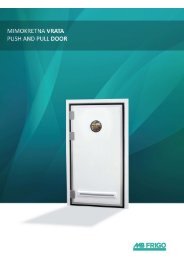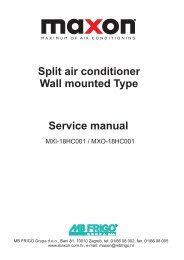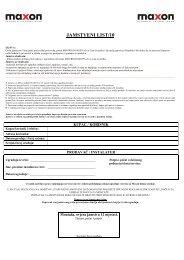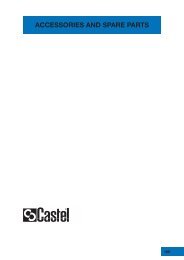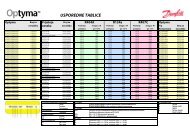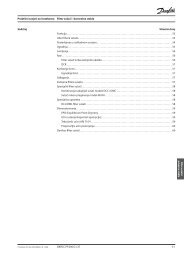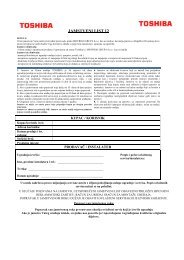Alco Controls
Alco Controls
Alco Controls
- No tags were found...
Create successful ePaper yourself
Turn your PDF publications into a flip-book with our unique Google optimized e-Paper software.
Oil Management Components<br />
Technical Information<br />
Refrigeration compressors are lubricated by<br />
refrigeration oil that circulates from the compressor<br />
crankcase or housing. As refrigerant gas is discharged<br />
by the compressor, it will leave with a fine oil mist, that<br />
will be circulated throughout the entire system.<br />
Small amounts of oil circulating through the system<br />
will not affect the system performance. Too much<br />
refrigeration oil circulating in the system will have<br />
adverse effects on the components in the system.<br />
Circulating oil reduces the ability of the system to<br />
effectively remove the heat. Condensers, evaporators<br />
and other heat exchangers loose efficiency when<br />
coated internally with an oil film.<br />
Refrigeration oil not returning to the compressor<br />
causes improper lubrication and eventual compressor<br />
failure. At low temperature application, refrigeration<br />
oil thickness becomes difficult to move, causing oil<br />
to be trapped in the system.<br />
Oil separator function<br />
Refrigerant gas leaving the compressor through the<br />
discharge line contains refrigeration oil in a vaporous<br />
mist. As this mixture enters the oil separator, the<br />
velocity is reduced to allow oil separation to begin.<br />
The refrigerant gas and oil mixture enters the oil<br />
separator and passes through an inlet screen,<br />
causing the fine particles to combine. Larger oil<br />
particles are formed and drop to the bottom of the<br />
oil separator.<br />
The refrigerant gas then passes through an outlet<br />
screen to remove residual oil particles. The oil<br />
gathers in the bottom of the oil separator until a<br />
float operated needle valve opens to allow the return<br />
of oil to the compressor. Oil returns quickly to the<br />
compressor, because of the higher pressure in the<br />
oil separator than in the compressor crankcase.<br />
When the oil level has lowered, the needle valve<br />
retracts to prevent refrigerant gas from returning<br />
back to the compressor. The refrigerant gas leaves<br />
through the outlet of the oil separator and goes to<br />
the condenser<br />
Oil level management system function<br />
This system provides oil level balancing as well as<br />
oil level monitoring including alarm and compressor<br />
shut-down functions. The oil level is measured<br />
inside the compressor‘s crankcase. By operating<br />
an integrated solenoid valve, missing oil can be<br />
fed from the oil receiver or from the oil separator<br />
directly into the compressor sump. If oil level drops<br />
to a dangerous level the alarm contact changes into<br />
alarm state. The alarm contact may be used to shut<br />
down the compressor. The integrated electronics<br />
includes delay times in order to avoid short-cycling<br />
and nuisance alarms.<br />
This system applies to compressor pack applications<br />
with multiple parallel compressor arrangements<br />
but also to stand-alone compressor applications<br />
for compressors without differential oil pressure<br />
monitoring.<br />
138 A2.5.1/0706/E


